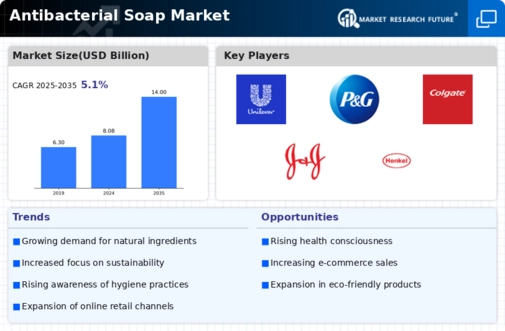E-commerce Growth
The expansion of e-commerce platforms is reshaping the Global Antibacterial Soap Market Industry by providing consumers with convenient access to a wide range of products. Online shopping has gained popularity, particularly among younger demographics who prefer the convenience of purchasing hygiene products from home. This shift has led to increased sales of antibacterial soaps through online channels, allowing brands to reach a broader audience. As e-commerce continues to grow, it is expected to play a pivotal role in driving market expansion, facilitating consumer access to various antibacterial soap options.
Regulatory Support
Government regulations and guidelines promoting the use of antibacterial products significantly influence the Global Antibacterial Soap Market Industry. Regulatory bodies advocate for enhanced hygiene practices, particularly in healthcare settings, which boosts the demand for antibacterial soaps. For instance, the Centers for Disease Control and Prevention (CDC) emphasizes the importance of hand hygiene in preventing healthcare-associated infections. Such endorsements create a favorable environment for manufacturers, leading to innovations and product development. This regulatory support is expected to contribute to the market's growth, with projections indicating a rise to 14.0 USD Billion by 2035.
Rising Health Awareness
The increasing global awareness regarding health and hygiene is a primary driver for the Global Antibacterial Soap Market Industry. Consumers are becoming more conscious of the importance of hand hygiene in preventing infections and diseases. This trend is reflected in the growing demand for antibacterial soaps, which are perceived as effective in eliminating harmful bacteria. As a result, the market is projected to reach 8.08 USD Billion in 2024, driven by this heightened awareness. Educational campaigns and public health initiatives further reinforce this trend, encouraging consumers to adopt antibacterial soaps as a standard hygiene practice.
Innovative Product Development
Innovation in product formulations and packaging is a crucial driver for the Global Antibacterial Soap Market Industry. Manufacturers are increasingly focusing on developing new antibacterial soap variants that cater to diverse consumer preferences, such as organic and natural ingredients. This trend is evident in the introduction of eco-friendly packaging and formulations that appeal to environmentally conscious consumers. As a result, brands that prioritize innovation are likely to capture a larger market share. The anticipated compound annual growth rate (CAGR) of 5.1% from 2025 to 2035 underscores the potential for growth driven by continuous product innovation.
Increased Demand in Emerging Markets
Emerging markets are witnessing a surge in demand for antibacterial soaps, significantly impacting the Global Antibacterial Soap Market Industry. As disposable incomes rise and urbanization accelerates, consumers in these regions are becoming more health-conscious and willing to invest in personal hygiene products. This trend is particularly evident in countries across Asia and Africa, where the adoption of antibacterial soaps is increasing. The growth potential in these markets is substantial, contributing to the overall market expansion and aligning with the projected growth trajectory of the industry.
















Leave a Comment